Key takeaways:
- Culinary education combines technical skills with a deep understanding of cooking science, enabling creativity and adaptability in the kitchen.
- Experimentation with ingredient substitutions and flavor combinations can lead to delightful surprises and enhancements in traditional recipes.
- Sharing personal adaptation stories fosters innovation and can uncover new flavor profiles and cooking techniques.
- Keeping a record of culinary experiments and seeking feedback encourages growth and improvement in cooking skills.
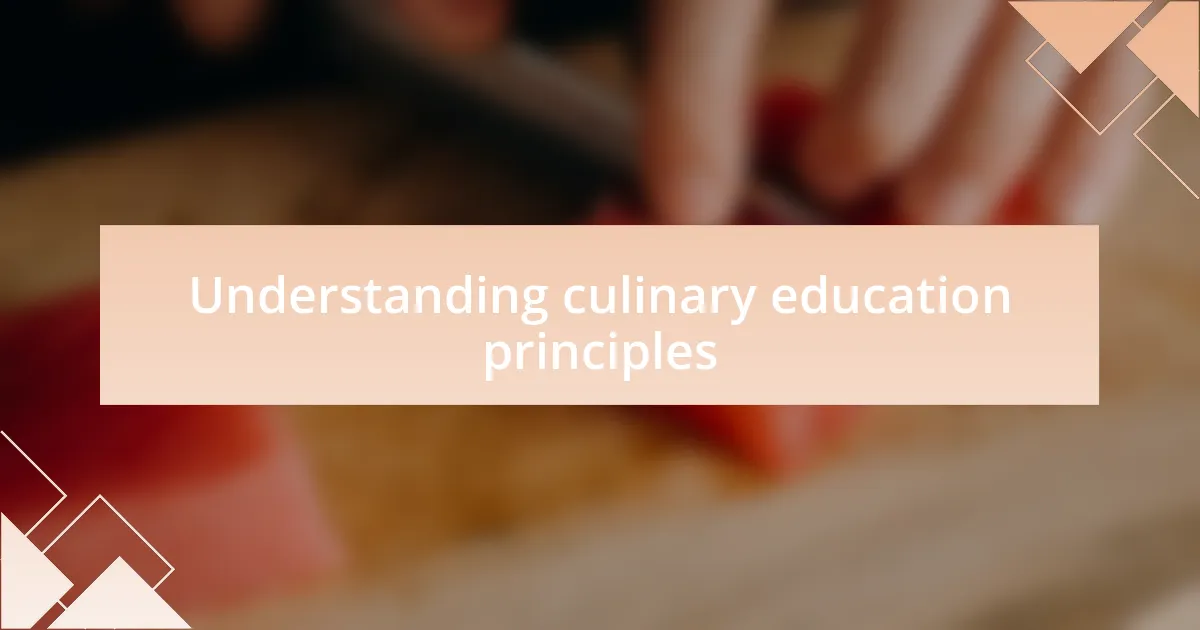
Understanding culinary education principles
Culinary education is built on a blend of technical skills and foundational knowledge. I remember my early days in culinary school when I struggled to grasp the science behind cooking techniques; it wasn’t just about following recipes but understanding why certain methods work better than others. What I discovered is that such insights empower us to adapt and innovate with confidence.
The principles of culinary education go beyond simply learning to chop vegetables or sauté. They encompass an understanding of flavor profiles, ingredient interactions, and cooking methods. For instance, as I progressed, I found that exploring the chemistry behind emulsification not only helped me master sauces but also inspired my creativity with dressings and dips. How might your cooking change if you dive deeper into the science of what you create?
Engaging with these principles often leads to surprising revelations. I vividly recall a time when I experimented with alternative sweeteners in a pastry class. By applying what I had learned about sugar’s role in texture and moisture, I was able to create deliciously light cookies. This experience reinforced my belief that deeply understanding the science of cooking is key to culinary success and adaptability in any kitchen.
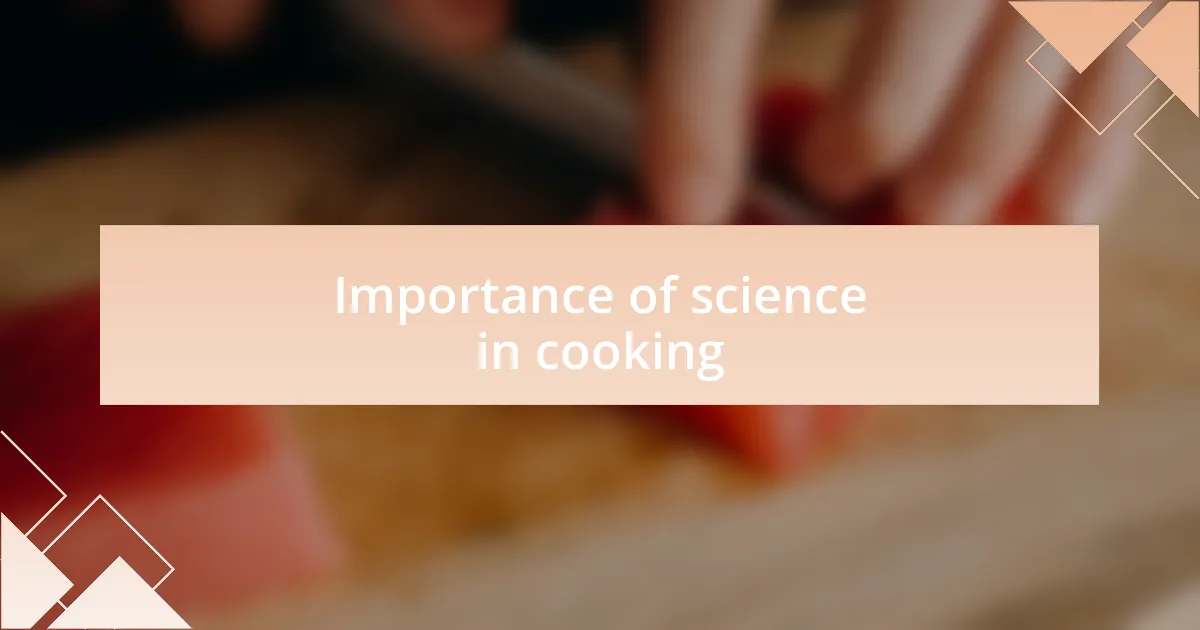
Importance of science in cooking
Diving into the science of cooking has profoundly shaped my culinary journey. I still remember making my first soufflé and feeling excited yet nervous. Understanding the science behind the egg proteins and how they react to heat gave me the confidence to know that I could successfully create a dish that would rise and impress. Isn’t it fascinating how the chemistry of ingredients can elevate a simple recipe into something extraordinary?
The connection between science and cooking is not just about theory; it’s about practical application in the kitchen. Take, for instance, the process of caramelization. My experimentation with onions taught me that patience is crucial. As I watched them slowly transform from simple slices to a sweet, golden brown, I realized that heat and time work together to develop complex flavors. How often do we rush in cooking, forgetting that sometimes the best things come with a little wait?
Moreover, understanding the various cooking methods, such as roasting versus steaming, has enabled me to make better choices for my dishes. A recent cooking project involved experimenting with different vegetables; by applying my knowledge about how heat affects cellulose breakdown, I was able to achieve the perfect texture and flavor. Reflecting on such moments, it becomes clear that scientific principles aren’t just abstract notions; they’re a toolkit for culinary excellence that enhances creativity and enjoyment in the kitchen.
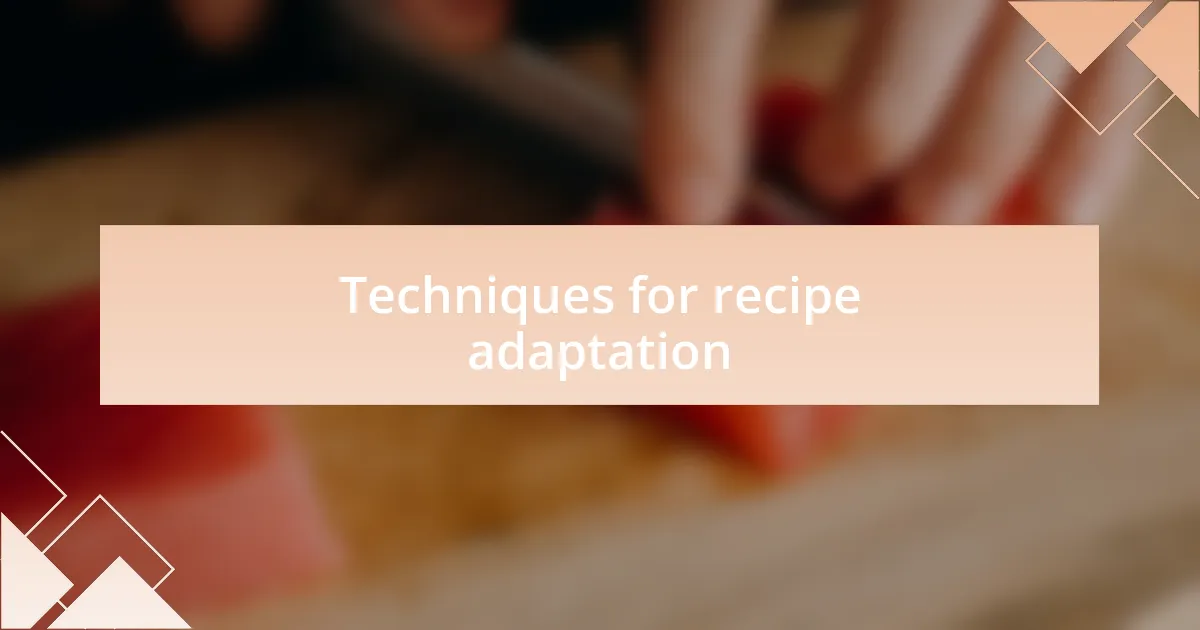
Techniques for recipe adaptation
Techniques for recipe adaptation often hinge on understanding the balance of flavors and textures. I recall a time when I decided to replace traditional pasta with spiralized zucchini for a lighter meal. Initially, I was hesitant—would the dish still have the same appeal? By adjusting the sauce to incorporate more robust flavors, I discovered that the creamy pesto I created elevated the dish in an unexpected way. Have you ever been surprised by how a simple substitution can lead to delicious discoveries?
Another valuable technique is to experiment with ingredients that serve similar functions. For instance, when I wanted to create a gluten-free cake but didn’t have almond flour, I turned to a blend of finely ground oats and coconut flour instead. It took a few tries to get the ratios right, but in that process, I learned that understanding ingredient properties—like the moisture content of coconut flour—can lead to successful adaptations. Isn’t it rewarding when a little science leads to delightful results?
Lastly, don’t underestimate the power of controlled experimentation. I remember testing different leavening agents while baking bread, alternating between baking soda and yeast. Each time I tried, I noted how the textures varied and the flavors deepened. It’s a simple reminder that adapting recipes is not just a replacement process but an invitation to explore new avenues in cooking. What new creations await when you throw caution to the wind and let your curiosity guide you?
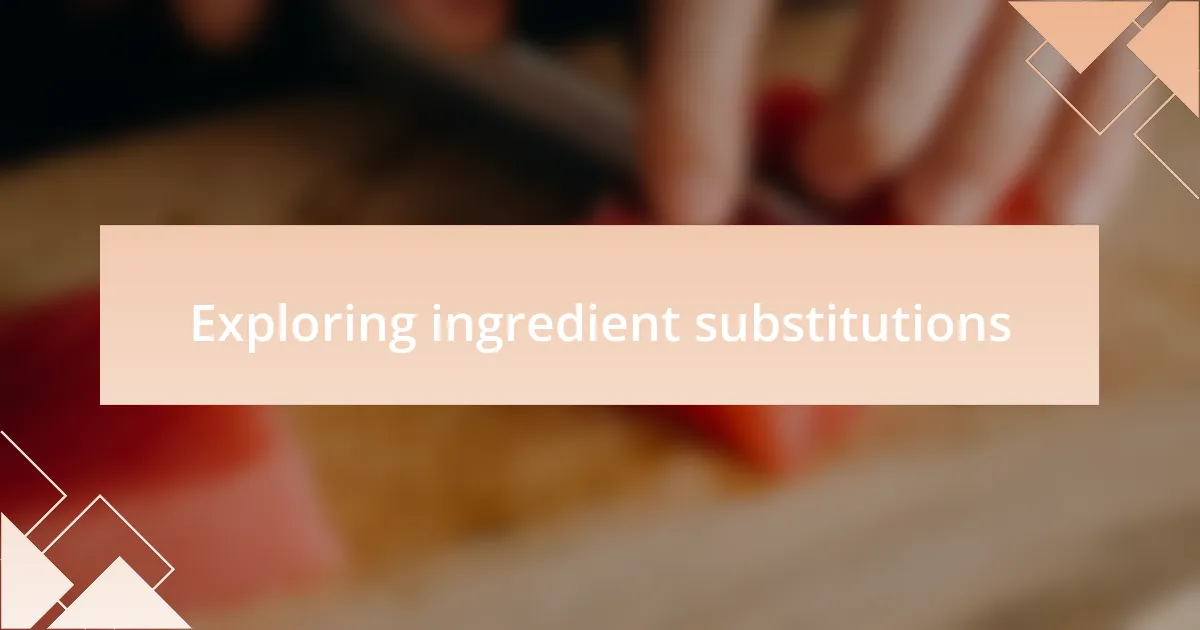
Exploring ingredient substitutions
When considering ingredient substitutions, I often find inspiration in what’s already in my pantry rather than running to the store. Once, while preparing a savory curry, I realized I was out of coconut milk. Instead of panicking, I mixed equal parts of plain yogurt and vegetable broth. Surprisingly, the yogurt added a delightful tang and creaminess that complemented the spices beautifully. Have you ever stumbled upon a substitution that changed your dish for the better?
The choice of substitutes also hinges on understanding the science behind the ingredients. For example, when I was making a traditional vinaigrette but ran out of olive oil, I used avocado oil instead. Not only did it bring a different flavor profile, but it also has a higher smoke point, making it a fantastic option for cooking at high heat. It was a friendly reminder that sometimes the best culinary shifts come from embracing what we have and adapting with intention.
Another instance that stands out is when I experimented with using black beans instead of ground beef in tacos. Initially, I was doubtful about the texture and flavor. However, by adding smoked paprika and cumin, I discovered that the beans could absorb the spices wonderfully, making for a hearty and satisfying filling. It’s fascinating how an open mind can turn a simple substitution into an exciting twist on a classic. What creative alternatives have you tried that surprised you?
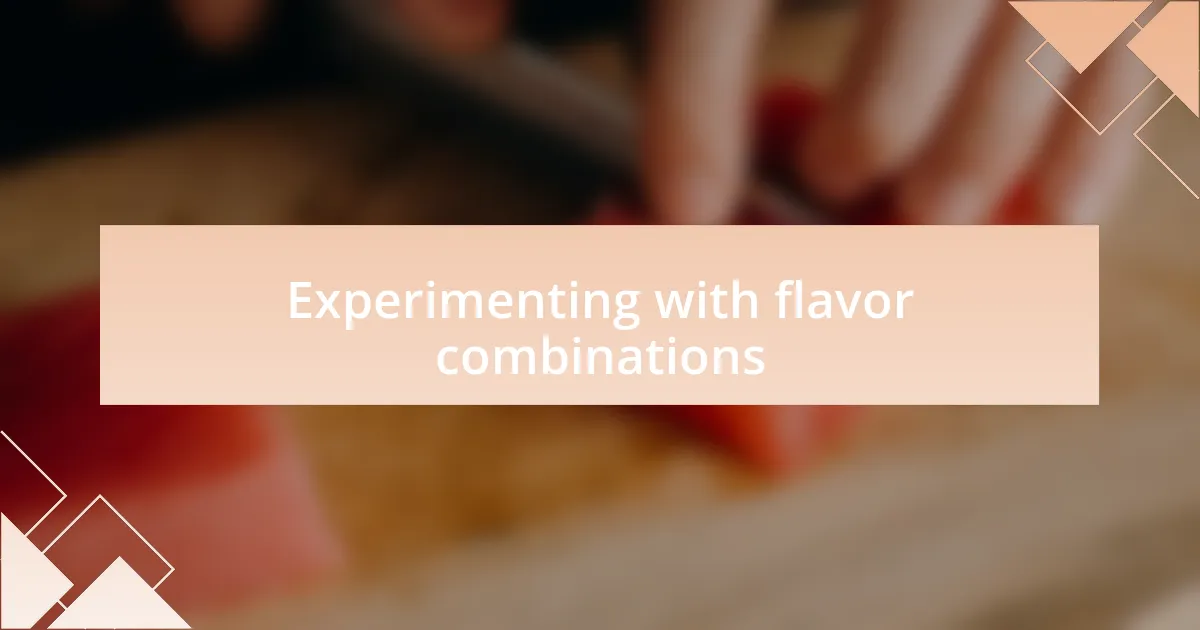
Experimenting with flavor combinations
Experimenting with flavor combinations is where the magic truly happens in the kitchen. I remember one day when I decided to combine sweet and savory, pairing fresh strawberries with balsamic vinegar—a decision that still excites my taste buds. The acidity of the vinegar elevated the sweetness of the strawberries, turning a simple salad into a vibrant dish. Have you ever tried blending flavors that seem incompatible? You might just discover a hidden gem.
One of my favorite experiments involved creating a chocolate chili sauce. Initially, I was skeptical about combining chocolate and spice, thinking it might be an unusual pairing. However, after adding just a pinch of cayenne to my homemade chocolate sauce, I was amazed at how the heat enhanced the rich cocoa flavor. This combination not only surprised my palate but also sparked creativity in other dishes, making me wonder what else I could meld together.
Another memorable experience was infusing herbs into unexpected foods. For instance, I decided to steep fresh basil in a simple syrup used for cocktails. This infusion added a refreshing twist that transformed a basic drink into something vibrant and aromatic. It felt like unlocking a new level in flavor exploration. What flavors have you experimented with that took your dishes to new heights?
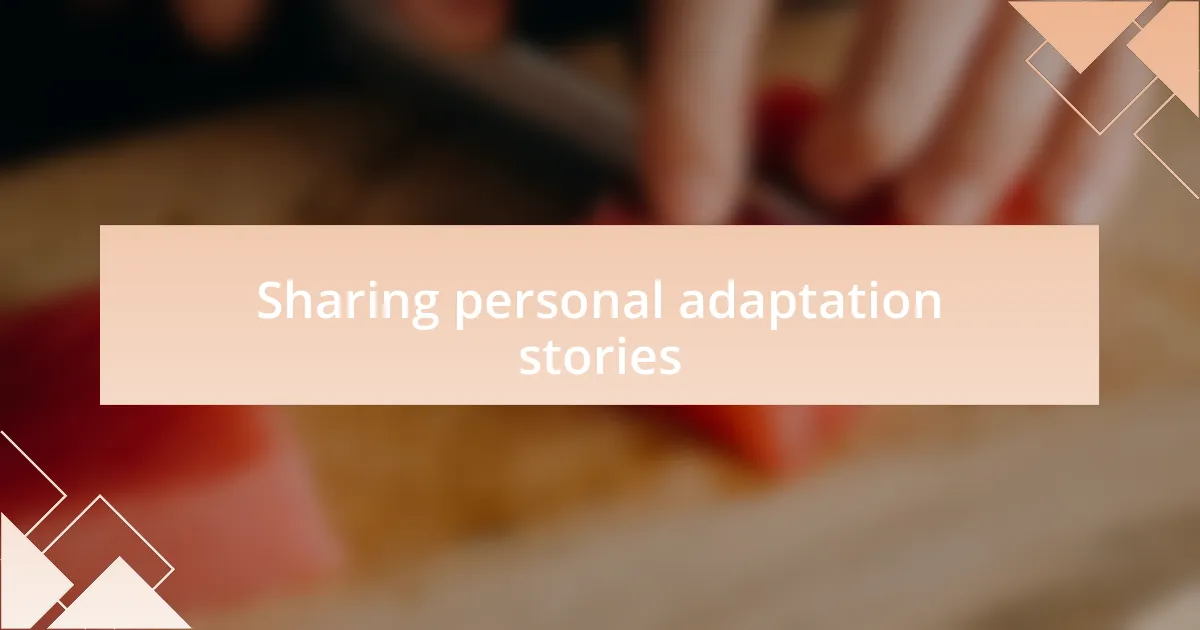
Sharing personal adaptation stories
Sharing personal adaptation stories can be such a rewarding part of cooking. One day, while attempting to recreate my grandmother’s famous lasagna, I realized I was out of ricotta cheese. Instead of giving up, I combined cottage cheese with a bit of cream and a sprinkle of herbs. The result not only maintained the essence of her recipe but also added a lightness that I hadn’t anticipated. Have you ever found a surprising substitute in your cooking that turned out even better than the original?
I vividly recall adapting a traditional curry recipe when I decided to experiment with coconut milk. Initially, I was hesitant because I loved the original dish’s depth. However, when I poured that creamy milk in, I discovered an entire dimension of flavor I had never experienced before—smooth, rich, and enveloping. How often do we overlook opportunities to innovate in our own cooking?
Another time, I faced a baking mishap when I didn’t have enough flour for my cookie dough. Instead of simply adjusting the ingredients, I added ground oats and a hint of orange zest. The cookies turned out chewy and aromatic, offering a delightful twist to the classic indulgence. This experience taught me that limitations can lead to remarkable creativity—what limitations have you turned into culinary breakthroughs?
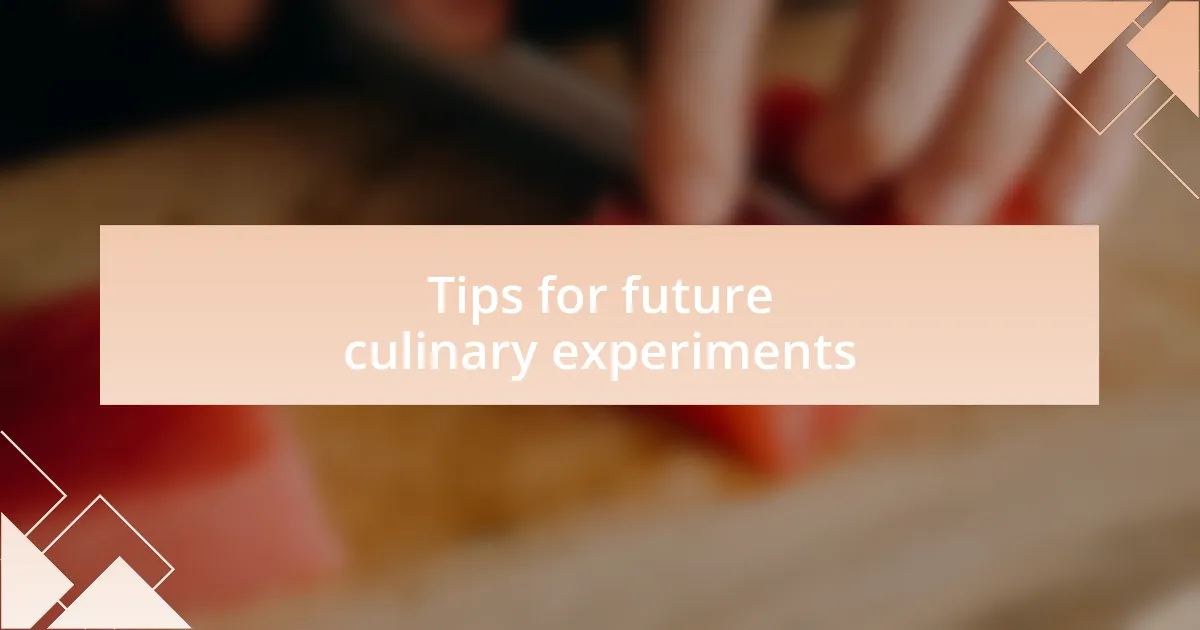
Tips for future culinary experiments
When planning your next culinary experiment, embrace the idea of trial and error. I remember experimenting with herbs in a simple omelet and, although my first attempt with sage was overwhelming, I learned to balance it with milder flavors like chives. Have you ever discovered that a small tweak could transform a dish entirely?
Another effective strategy is to keep a record of your experiments. It’s amazing how quickly we forget what worked or didn’t work in the kitchen. I started maintaining a small notebook dedicated to recipes and adaptations, which has not only aided my future cooking adventures but also turned into a treasure trove of personal insights. Have you considered documenting your culinary journey?
Lastly, don’t hesitate to ask for feedback from others. During one of my dinner parties, I served a revamped family recipe and encouraged guests to share their thoughts. Their honest reactions helped me refine the dish further, turning a good experiment into a great one. How often do you involve others to enhance your culinary creativity?